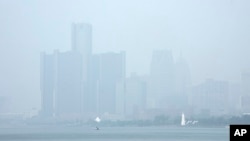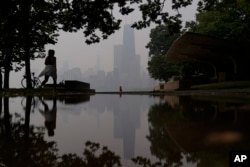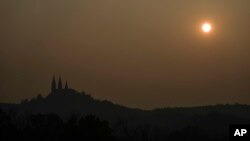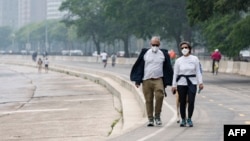The Detroit area woke up Wednesday to some of the worst air quality in the United States as smoke from Canada's wildfires settled over most of the U.S. Great Lakes region and unhealthy haze spread southward, as far as the southern states of Missouri and Kentucky.
Drifting smoke from the wildfires has lowered curtains of haze on broad swaths of the United States, pushing into southern Illinois, Indiana and Ohio, and moving into parts of West Virginia.
The Environmental Protection Agency's AirNow.gov site showed Detroit in the hazardous range and warned that "everyone should stay indoors and reduce activity levels." Chicago, Indianapolis, Cleveland, Ohio; and Pittsburgh all have very unhealthy air. A wider circle of unhealthy air spread into St. Louis and Louisville, Ky.
"The more breaths you're taking, you're inhaling, literally, a fire, camp smoke, into your lungs," said Detroit resident Darren Riley, who said he would wear a mask if he had to go outside at all on Wednesday.
The smoke is exacerbating air quality issues for poor and Black communities that are more likely to live near polluting plants and in rental housing with mold and other triggers.
Detroit's southwest side is home to a number of sprawling refineries and manufacturing plants and has battled air pollution for decades. It is also one of the poorest parts of a mostly Black city, which has an overall poverty rate of about 30%. According to a 2022 report by the American Lung Association, the city's ozone and short-term particle pollution ranked among the worst in the nation.
Riley said he was diagnosed with asthma in 2018 a few years after moving to Detroit, and the poor air quality in parts of the city prompted him to start JustAir, which provides air pollution monitoring.
"Just because you're born in a certain ZIP code or you're born into a certain family with a certain skin color doesn't mean that you should have an unequal go at it," said Riley, who is Black.
Elsewhere, Milwaukee County Emergency Medical Services has seen a spike in calls for residents with respiratory complaints, the Milwaukee Journal Sentinel reported. Office of Emergency Management data show a disproportionate number of calls for respiratory issues – 54.8% – have been for Blacks in Milwaukee, according to the newspaper. Milwaukee County's population is 27.1% Black.
In Chicago, Mayor Brandon Johnson urged young people, older adults and residents with health issues to spend more time indoors and pledged "swift action to ensure that vulnerable individuals have the resources they need to protect themselves and their families."
Minnesota issued a record 23rd air quality alert for the year through late Wednesday night, as smoky skies obscured the skylines of Minneapolis and St. Paul. Michigan, Wisconsin and Indiana were among other states issuing air quality alerts, and cities including Louisville also advised people to limit prolonged or intense outdoor activity.
"This is particularly thick smoke," National Weather Service meteorologist Byran Jackson said Wednesday.
Jackson added that another round of smoky air is going through western New York, western Pennsylvania later Wednesday.
"And then that continues over the northern Mid-Atlantic [states]. It will persist there into Thursday," he said.
Across Canada, 490 fires are burning, with 255 of them considered to be out of control.
The Canadian Interagency Forest Fire Center reported Monday that 76,129 square kilometers (29,393 square miles) of land including forests has burned across Canada since January 1. That exceeds the previous record set in 1989 of 75,596 square kilometers (29,187 square miles), according to the National Forestry Database.
Some wet weather in Quebec gave firefighters a chance to get ahead of some of the flames, but there hasn't been enough rain to extinguish the wildfires.
Environment Canada meteorologist Simon Legault said he expects rain to stop falling by Wednesday morning in the regions most affected by forest fires. Many of the fires burning in Canada are in Quebec and Ontario, nearer to North America's most populated areas than Western wilderness areas.
Earlier this month, massive fires burning stretches of Canadian forests blanketed the northeastern United States and the Great Lakes region with smoke, turning the air yellowish gray and prompting warnings for people to stay inside and keep windows closed.
The small particles in wildfire smoke can irritate the eyes, nose and throat, and can affect the heart and lungs, making it harder to breathe. Health officials say it's important to limit outdoor activities as much as possible to avoid breathing in the particles.








